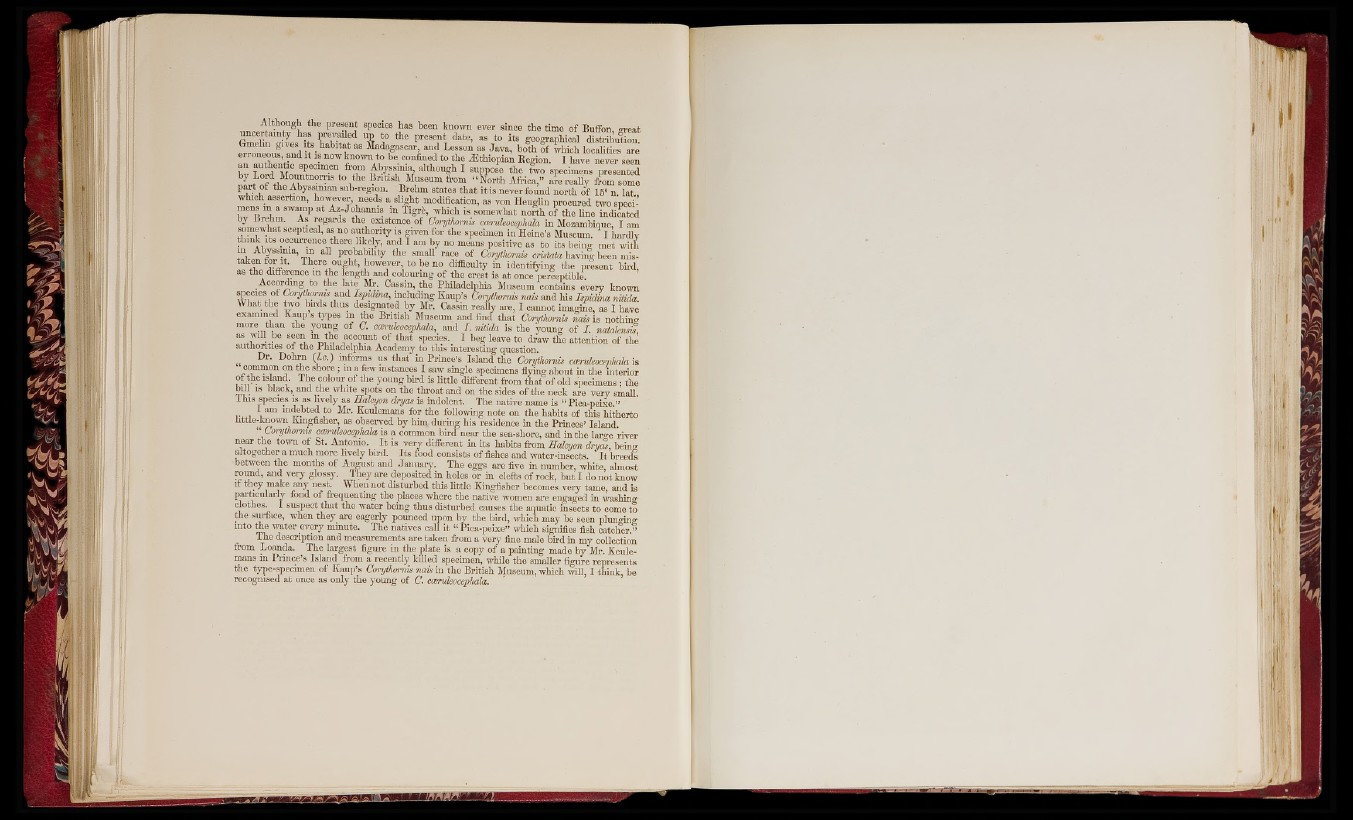
H
„T r eZ n te t u p resen t species has been known ever since th e time o f Buffon, great
u n c e ita in ty has prevailed u p to the p resen t date, as to its geographical d istribution
Gmelm gives its^ h a b i t / as Madagascar, and Lesson as Jav a, bo th o f which localities are
erroneous, an d i t is now known to be confined to th e /Eth io p ian Region. I have nevei- seen
t o L o t Î X i S “ / T r ft® tw° specimens presented
n L to r e Z Z - 1, B ritish Museum from “ No rth Africa," aÎ-ereaUy from some
p a r t o f th e Abyssmian sub-region. Brehm states th a t i t is never found n o rth o f 15» n lat
which assertion, however, needs a s lig h t modification, as von Heuglin procured two speci-
mens m a swamp a t A / J o h a n n is m Tigrè, which is somewhat n o rth o f th e lin e indicated
by Brehm. As regards th e existence o f Coiytliomis coeruleocephala in Mozambique I am
somewhat sceptical, as no au th o rity is g iven for th e specimen in Heine’s Museum. I hardly
th in k Its occurrence th ere likely, and I am b y no means positive as to its being m et with
m Abyssmia, m all probability th e small race o f Corythonm cm ia ia having been mis-
+T Z f f »¥®® /w /® ® , to be no difficulty in identifying th e p resent bird,
s th e difference m th e len g th and colouring o f th e crest is a t once perceptible
...uoreuoe m lue leu in a n a coiourmg ot tn AocOTdmg ■ding to th e la te Mr. Cassin, th e Philadelphia Philadelnhia Museum contains eoutnius
every known
w r / l f Ispidma, ineluding Kanp’s Corythomü nais and his Isp idL a nilida.
VV Hat th e rivo bird s th u s designated b y Mr. Cassm really are, I cannot imagine, as I have
examined Kaup s types in to e B ritish Museum and find th a t Corythonm nais is n o th in g
more th an th e y o u n g o f C. coeruleoaphala, and I . nitida is th e y o u n g o f I . n a ta kn sS
as will be s / n m th e account o f th a t species. I beg leave to di-aw th e a tten tio n o f to?
au th o ritie s o f th e Philadelphia Academy to this interestmg question.
Dr. Do h rn { l c .) i^ o rm s us th a t in P rin c e ’s Island th e Corythornis coeruleocephala is
common on th e shore ; m a few instances I saw single specimens flying about in th e interior
oi the island. I h e colour o f th e y o u n g b ird is little different from th a t o f old specimens ; the
bill IS b l ^ k , and th e white spots on th e th ro a t and on th e sides o f th e neck are v e ry small,
l li is species is as lively as Halcyon dryas is indolent. The native name is “ Pica-peixe.”
J- am m ÿ b te d to Mr. Keulemans for th e following note on th e habits o f th is h ith erto
h ttie -to ow n Kmgfisher, as obseiwed b y him d u rin g his residence in th e Princes’ Island.
Coiythornis coeruleocephala is a common bfrd ne ar th e sea-shore, and in th e larcre rive r
n e a r th e town of St. Antonio. I t is v e ry different in its h abits from Halcuon dryas, beino-
alto g e th e r a m uch more lively b ird. I ts food consists o f fishes and water-insects. I t breeds
between th e months o f A u g u st and Jan u ary . The eggs are five in number, -white, almost
rou n d , and v e ry glossy. They are deposited in holes o r in clefts of rock, b u t I do n o t know
if th ey make any nest. When n o t d isturbed tliis little IQngfisher becomes very tame, and is
parricularly fond o f frequenting the places where the native women are engaged in washing
clothes.^ I suspect th a t th e wa te r being th u s disturbed causes th e aquatic insects to come to
th e surface, when th ey ai-e eagerly pounced upon b y the bfrd, which may be seen plungino-
in to th e water every minute. The natives call i t “ Pica-peixe” which signifies fish catclfer.”
I h e description and m easurements are tak en from a v e ry fine male bfrd in my collection
from Loanda. ’T'Lq lown-cof .<• • -i . v.r —
mans in P rin ce „
th e type-specimen o f K au p £ . . . . . . xxx uxio xjnuic
recognised a t once as only th e young o f C. coeruleocephala.